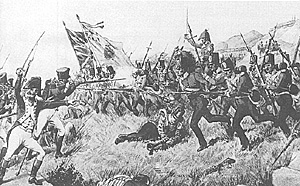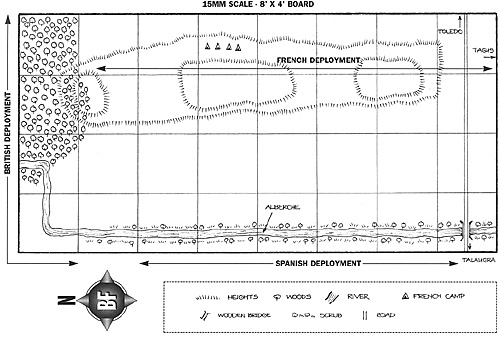
This "what-if" Peninsular War battle was played, by members of Shoeburyness Wargames Club, as a demonstration game at the Tower of London during Partizan Press' seminar there last year. It crystallised the concept of providing wargamers with full details of battles which never actually happened! However, this is one battle that very nearly did happen and would almost certainly have meant that the enormous monument now above the motorway just north of Talavera-de-la-Reina would never have been built. Instead of contesting the Battle of Talavera on the 27th/28th July 1809, Marshal Victor would likely have been in full retreat after, at the very least, a severe mauling. Or would he....?
The description of the ground taken up by Victor at Casalegas, in Oman, is fairly detailed and so a map for the table has been easy to produce. His dispositions, however, are not given so wargamers are free to make their own decisions. What Oman does state, is that the line was "...rather too long..." for Victor's force to occupy in complete safety.
Cuesta had sent Zayas (presumably Jose - Oman is not specific) and Albuquerque forward to the river line during the previous night leaving the rest of his army in and about Talavera. Wellesley had placed the 3rd Division and Anson's Dragoons in position, facing Victor's right flank (the rest of the British force was a few miles to the rear - say an hour's march). At 3 am on the 23rd, the 1st Division was marched to out-flank Victor and were joined by the 3rd Division. They halted in front of the fords to await Cuesta's attack.
Historically, that attack was never delivered. Cuesta, apparently suffering from his injuries received at Medellin and possibly a foretaste of the illness that killed him three years later is variously reported as telling Sir Arthur, when he rode to the Spanish front line, that his troops were too tired; it was a Sunday; there had been inadequate reconnaissance; he was unsure of the fords; the bridge would not support artillery; etc. the upshot was that Victor was not disturbed during the 23rd. The British were not, in Wellesley's opinion, strong enough to tackle the French alone and, that night, Victor and his army retired unmolested. They joined Sebastiani and Joseph at Toledo, caught a re-invigorated Cuesta napping on 26th July, an event of which the Spaniard was warned by Sir Arthur when the former refused to retire to Talavera with him on the 24th, instead chasing after the French. After a hurried disengagement, Cuesta did join with the British and the Battle of Talavera was fought on the 27th and 28th.
My recommendations for Casalegas are as follows:
- 1 Assume Cuesta attacks as planned and is supported by the British as was agreed.
2 Assume Zayas & Albuquerque do not learn of their chief's torpor and commence the planned attack but that Cuesta does nothing until hearing the sounds of battle. At this point, dice for his reaction a) he moves forward with speed (25% chance) b) he moves forward a division at a time - say at half-hour intervals (25% chance) c) he sends only part of his army - determine what proportion using die rolls - (25% chance) d) he leaves Zayas and Albuquerque in the lurch (25% chance).
3 Assume Wellesley does not wait for Cuesta and goes ahead with his flank attack. You will need to determine Cuesta's response, using the above options.
FORDS
Determine how many fords you wish to allow along the Alberche (not too many, say 10 in all). Place markers at intervals along the river to show where the fords are, including along the 'British' table edge, but only allow crossing by troops after the fords are "confirmed" by a suitable die roll (4-6 on a six-sided die) on the part of investigating light cavalry or light infantry positioned near the markers.
TROOP QUALITY
For the purpose of this battle, I suggest the following classifications:
- A = Elite (e.g. French Old Guard; British 95th Rifles. None present).
B = Veteran (British Guards; Joseph's Guard; all Artillery crews).
C = Average (French & British line; Spanish regular infantry; Spanish Cavalry Regiment "del Rey"; Loyal Lusitanian Legion).
D = Levies/Militia (Spanish non-regular infantry; all other Spanish cavalry; Portuguese).
E = Peasants/Guerillas (None present).
The principle is, for those whose rules do not cover troop classifications, that the higher the training, experience, etc, of the troops, the better their musketry, morale and melEe capabilities, so the better troops should benefit under the rules (morale & fire bonuses plus melEe advantage over lower class opponents) logical, eh?
The above list is not exhaustive and a unit's classification might change at various stages of the war in which it is involved. It forms a raw guide for wargamers to adjust, amend (or discard!) to their own views, researches and experiences.
REINFORCEMENTS
In view of the fact that Sebastiani had a 3 day march and King Joseph one of 4 days, their arrival would depend on very prompt action by the King; historically, he only learned of the presence of the British army in the district on 22nd. This would have to be coupled with a march of such prodigious speed that it would have rivalled the 46 miles in 22 hours achieved by the Light Division in an attempt to reach Talavera in time for the battle. Robert Craufurd proved it could be done (with some considerable sacrifice) but his men were exhausted on arrival (too late to affect the battle, as it happened).
Sebastiani was watched by Venegas and might have obtained intelligence on Wellesley's presence earlier. He might also have left Toledo with a small force left to watch the Spanish general.
Venegas, himself, was either insubordinate or under conflicting orders and I judge it unlikely that he would have reinforced Cuesta. In any case, he would almost certainly have been too dilatory to arrive at any worthwhile point. I have not, therefore included an orbat for his force.
Sir Robert Wilson was a different matter. He was resourceful and brave even if he was not the most tactically competent or obedient of
Wellesley's sub-ordinates. The strength of his force was much exaggerated in King Joseph's intelligence and he might well appear in the rear of a reinforced Victor if Joseph's is the reinforcing corps. In the case of French reinforcements from Madrid, Wilson should be given a high chance of arriving in the French rear at some stage.
How these possibilities and considerations affect your playing of the scenario is up to you. The use of an umpire or pre-written notes in sealed envelopes to be opened on the basis of die rolls at various stages of the battle, are favourite methods of mine. I will not try to impose timings or make suggestions on the precise nature of these methods, since they would belabour the obvious and I believe in encouraging others to use their own initiative whenever possible.
SOME RANDOM THOUGHTS
It is always more interesting if ammunition is limited (not too much) and replenishment from stores to the rear allowed (with a delay).
I like to have some hidden deployment on the table. Our club (Shoeburyness) use hidden terrain features - small chits with such legends as "hidden gully - linear obstacle to cavalry"; "marsh x% possibility of light casualties"; "broken/rocky ground - x points disorganisation/no cavalry charges"; etc., are placed face down in appropriate places. These can only be revealed if physically reached by a unit on the table. The effects are then applied for a radius around the chit (decided by dice).
I would welcome comments from those of you who play the scenario perhaps we could prevail upon the magazine's editor to print some of these as a follow-up to my effort. If you notice any inaccuracies or discrepancies in my data, please let me know. I hope you enjoy the scenario.
Map

Casalegas 23rd July, 1809
- Historical Background
The Generals
Orders of Battle: French
Orders of Battle: British
Orders of Battle: Spanish
Wargaming the Battle
Back to Battlefields Vol. 1 Issue 1 Table of Contents
Back to Battlefields List of Issues
Back to Master Magazine List
© Copyright 1995 by Partizan Press.
This article appears in MagWeb.com (Magazine Web) on the Internet World Wide Web.
Other articles from military history and related magazines are available at http://www.magweb.com